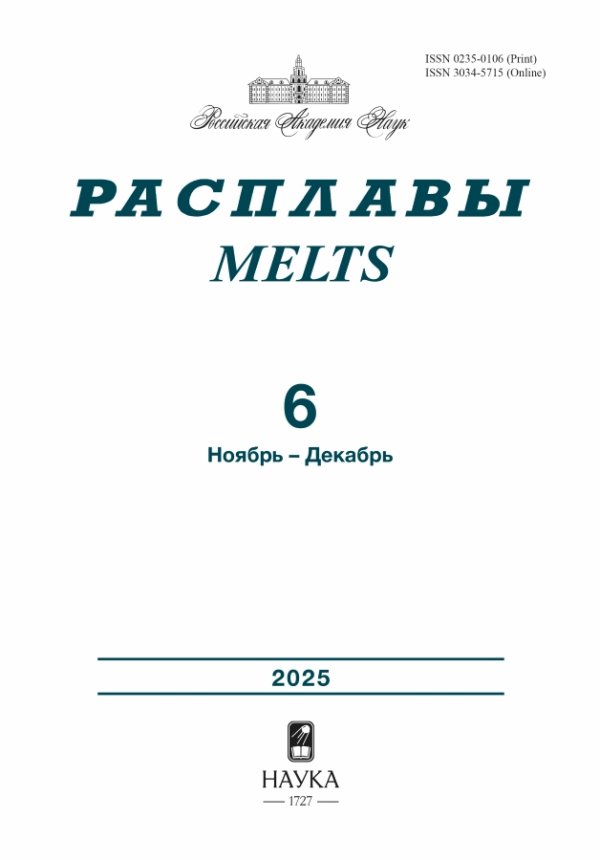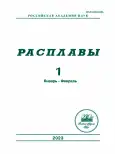Анализ структурных единиц и их стабильности в расплаве Na2О–B2O3 методом первопринципной молекулярной динамики
- Авторы: Юрьев А.А.1, Цымбалист М.М.1, Самойлова М.А.1, Хохряков А.А.1
-
Учреждения:
- Институт металлургии Уральского отделения РАН
- Выпуск: № 1 (2023)
- Страницы: 22-38
- Раздел: Статьи
- URL: https://journals.rcsi.science/0235-0106/article/view/138530
- DOI: https://doi.org/10.31857/S0235010623010115
- EDN: https://elibrary.ru/HCLEND
- ID: 138530
Цитировать
Полный текст
Аннотация
Целью настоящей работы являлась разработка расчетно-теоретической методики детального изучения геометрии и статистических характеристик локальных структурных комплексов сложных жидкостей типа щелочноборатных систем, имеющих тенденцию к образованию объемной борокислородной сетки. Методика отрабатывалась на примере расплава 30Na2O–70B2O3 при Т = 1273 К. Использовалась первопринципная молекулярная динамика, реализованная в программном коде VASP для суперячейки из 250 атомов. Полученные на каждом шаге координаты ионов использованы для получения статистически значимой информации о детальной структуре расплава. По разработанной для этой цели оригинальной программе были определены парциальные функции радиального распределения атомов и проанализированы все найденные в модели ближайшие координации вокруг каждого сорта ионов, определены типы и количество устойчивых группировок, длины связей и углы в них. Кроме того, рассчитан критерий тетраэдричности для единиц ВО4 и ВB4. Базовыми структурными единицами оказались почти правильные треугольники (в них входит ~80% атомов бора) и тетраэдры (~19% атомов бора) с ионом бора в центре и ионами кислорода в вершинах. Эти простые структуры образуют борокислородную сетку связанную общими (мостиковыми) атомами кислорода, причем она включает практически все атомы бора. Обнаружены надструктурные единицы, а именно комбинации из трех и более базовых структур. Например, два треугольника и один тетраэдр, образуют кольца из шести чередующихся атомов бора и кислорода. Кроме того, обнаружено существование колец, которые сформированы из четырех базовых структурных единиц, но они, в отличие от шестиатомных колец, не являются планарными образованиями. Предложенная методика позволяет получать практически любые данные о структурных особенностях систем такого типа, в частности, ответить на важный вопрос о количестве мостиковых и немостиковых атомов кислорода. Оказалось, что мостиковых кислородов в изученной системе примерно 86%. Использованный подход корректно учитывает ковалентную и ионную связи в жидких системах на основе оксидов-сеткообразователей и оксидов-модификаторов, что позволит изучить изменение локальных структурных характеристик в зависимости от концентрации и температуры и объяснить поведение различных физико-химических свойств.
Об авторах
А. А. Юрьев
Институт металлургии Уральского отделения РАН
Автор, ответственный за переписку.
Email: yurev_anatolii@mail.ru
Россия, Екатеринбург
М. М. Цымбалист
Институт металлургии Уральского отделения РАН
Email: yurev_anatolii@mail.ru
Россия, Екатеринбург
М. А. Самойлова
Институт металлургии Уральского отделения РАН
Email: yurev_anatolii@mail.ru
Россия, Екатеринбург
А. А. Хохряков
Институт металлургии Уральского отделения РАН
Email: yurev_anatolii@mail.ru
Россия, Екатеринбург
Список литературы
- Krogh-Moe J. // Phys. Chem. Glasses 1969. 6. 2. P. 46–54. https://doi.org/10.1016/0022-3093(69)90025-8
- Yano T., Kunimine N., Shibata S., Yamane M. // J. Non-Crystalline Solids. 2003. 321. P. 147–156. https://doi.org/10.1016/S0022-3093(03)00159-5
- Osipov A.A., Osipova L.M. // GlassPhys. Chem. 2009. 35. P. 121–131. https://doi.org/10.1134/S1087659609020011
- Handa K., Kita Y., Kohara S. // J. Physics and Chemistry of Solids. 1999. 60. P. 1465–1471. https://doi.org/10.1016/S0022-3697(99)00143-2
- Fábián M., Sváb E., Proffen T., Veress E. // J. Non-Crystalline Solids 2010. 356. P. 441–446. https://doi.org/10.1016/j.jnoncrysol.2009.12.013
- Guillaume F., Charpentier T., Seitsonen A.P., Takada A., Lazzeri M., Cormier L., Calas G., Mauri F. // Phys. Rev. Lett. 2008. 101. 065504. https://doi.org/10.1103/PhysRevLett.101.065504
- Бубнова Р.С., Филатов С.К. Высокотемпературная кристаллохимия боратов и боросиликатов. Санкт-Петербург: Наука, 2008.
- Kaiura G.H., Toguri J.M. The viscosity and structure of sodium borate melts // Physics and chemistry of glasses // Phys and Chem Glasses. 1976. 17. № 3. P. 62–69.
- Shartsis L., Capps W., and Spinner S. Viscosity and electrical resistivity of molten alkali borates // J. Am. Cer. Soc. 1953. 36. № 2. P. 35–43.
- Claes P., Coq J.L., Glibert J. // Electrochimica Acta. 1988. 33. P. 347–352. https://doi.org/10.1016/0013-4686(88)85027-8
- Melchakov S.Y., Khokhryakov A.A., Samoilova M.A., Ryabov V.V., Yagodin D.A. // Glass. Phys. Chem. 2022. 48. № 3. P. 174–179. https://doi.org/10.1134/S1087659622030063
- Khokhryakov A.A., Melchakov S.Y., Samoilova M. A., Ryabov V. V. // Inorganic materials. 2022. 58. № 5. P. 538–543. https://doi.org/10.1134/S0020168522050053
- Cristos-Platon E., Varsamis // Phys. Rev B. 2002. 65. P. 104203-104217. https://doi.org/10.1103/PhysRevB.65.104203
- Ohkubo T., Takahiro O., Tsuchida E., Gobet M., Sarou-Kanian V., Bessada C., Yasuhiko I. // J. Phys. Chem. B. 2013. 117. P. 5668–5674. https://doi.org/10.1021/jp312486m
- Yuryev A.A., Samoylova M.A. // J. Structural Chemistry. 2020. 61. 5. P. 681–687. https://doi.org/10.1134/S0022476620050029
- Xu Q., Kawamura K., Yokokawa T. // J. Non-Cryst. Solids. 1988. 104. P. 261–272. https://doi.org/10.1016/0022-3093(88)90397-3
- Kita Y., Misawa M. Umesaki N., Kirihara T., Fukunaga T., Iida T. ISIJ International. 1993. 33. № 1. P. 188–194. https://doi.org/10.2355/isijinternational.33.188
- Umesaki N., Kita Y., Kirihara T., Iida T., Fukunaga T., Misawa M. // J. Non-Crystalline Solids.1994. 177. P. 200–207. https://doi.org/10.1016/0022-3093(94)90531-2
- Pooja S., Pente A.A., Mandar D.S., Chowdhri I.A., Sharma K., Goswami M. Kalsanka T.S., Sadhana M. // J. Phys. Chem. B. 2019. 123. P. 6290–6302. https://doi.org/10.1021/acs.jpcb.9b03026
- Kresse G., Furthmuller J. // Phys. Rev. B. American Physical Society. 1996. 54. P. 11 169–11 186. https://doi.org/10.1103/PhysRevB.54.11169
- Цымбалист М.М., Юрьев А.А. Свидетельство о государственной регистрации программы для ЭВМ № 2020618833 программа для ЭВМ “StatXYZ”.
- Errington J.R., Debenedetti P.G. // Nature. 2001. 409. P. 318–321. https://doi.org/10.1038/35053024
- Kumar P., Buldyrev S.V., Stanley H. E. PNAS. 2009. 106. № 52. P. 22130–22134. www.pnas.org/cgi/doi/10.1073/pnas.0911094106
- Alderman O.L.G. // J. Phys. Chem. C. 2015. https://doi.org/10.1021/acs.jpcc.5b10277
- Majérus O., Cormier L., Calas G., Beuneu B. // Phys. Rev. B. 2003. 67. P. 024210–024217. https://doi.org/10.1103/PhysRevB.67.024210
- Kamitsos E.I., Chyssikos G.D. Solid State Ionics 1998. 105. P. 75–85. https://doi.org/10.1016/S0167-2738(97)00451-7
Дополнительные файлы
















